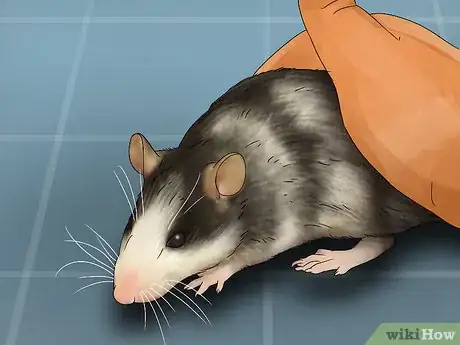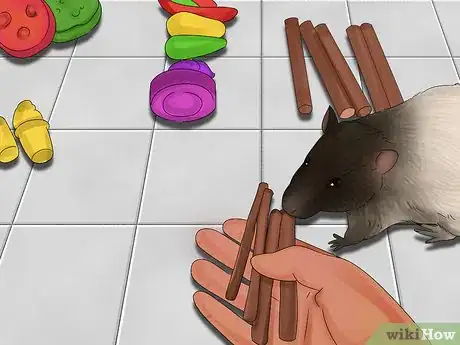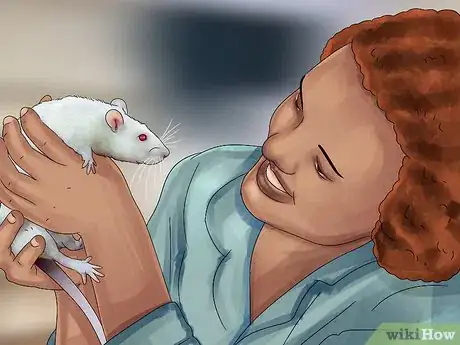This article was co-authored by Brian Starr. Brian Starr is a Rat Specialist and Breeder and the Owner of OC Dumbos out of Central Florida. As America’s only breeder of pet Roof Rats, Brian and OC Dumbos specialize in rat breeding, training, and care. Years of experience and several generations of careful breeding have allowed Brian and OC Dumbos to create a line of tame Roof Rats, bred to make friendly, fun pets. In addition to offering rat accessories and training resources, OC Dumbos also offers free Roof Rat adoptions.
There are 21 references cited in this article, which can be found at the bottom of the page.
This article has been viewed 22,865 times.
Pet rats are a terrific addition to a family of any size. While these pet rats require much attention and interaction, they are also intelligent, social and empathetic pets. Picking the right rat for you and properly acclimating it to its new home will set you up for success as a pet rat owner.
Steps
Picking Your Rat
-
1Decide if you want a male or female. While both males and females make wonderful pet rats, there are differences between the sexes. Males tend to be larger than females and are more docile, making them more suited as lap pets. They are also more likely to urine mark their territory and stain carpets and furniture. Females are more energetic and prefer to run and play rather than being held. Unfortunately, they’re also more prone to mammary tumors.[1] Rats are happiest when living with a companion, so you might consider buying a pair.[2]
- If you decide to adopt a male and female, make sure to spay and neuter your pets. Female rats can become pregnant beginning around five weeks of age, and will reproduce all year long with up to a dozen babies at a time.[3]
-
2Choose your variety. There are several types of rats you can bring into your home as pets. The domestic rat is the most common for its simplicity, and because it has not undergone any mutations. Manx rats are larger and tailless, which means they need more attention, as rats use their tails for balance and to regulate their metabolisms. Dumbo rats have larger ears and can be friendlier than other breeds.[4] Rex rats are the largest breed and, like hairless rats, tend to be better for those with allergies because of their shorter fur.[5]
- The Rat and Mouse Club of America (RMCA) website provides even more detailed information about rare rat breeds, markings and characteristics.[6]
Advertisement -
3Buy a baby rat if you're a first time pet rat owner. Rats only live 2-4 years under the best of circumstances, so purchasing them shortly after birth allows you the most time with your new pet. Baby rats can require more attention, but you’ll have the opportunity to socialize and get to know them from their early days of life.[7]
- If you want more than one pet rat, this is an especially good idea, as it’s easier to introduce rats to each other when they’re younger.[8]
-
4Rescue an older rat if you're an experienced pet rat owner or want to know the rat's personality. Adult rats already have developed personalities but may also come with trust issues, especially if they were not socialized properly as babies or came from a home where they were neglected or abused.[9]
Buying Your Rat
-
1
-
2Get a rat from a reputable adoption source if you want to rescue an animal. The Humane Society and your local animal shelter often take in older, abandoned rats or rat litters without a home.[12] If you do go this route, spend time with your rat before adopting to make sure its demeanor and personality match yours. [13]
- For example, if a rat appears skittish, bites or has other behavioral issues, it may have been abused or neglected. Make sure you have the time necessary to build trust with your new pet, as it will require patience and persistence.[14]
-
3Purchase from a pet store that specializes in rats. Many pet stores keep rats as snake food and therefore, do not take the best care of these animals.[15] . If you choose to buy your rat from a pet store, research stores where rats have been raised and properly cared for, especially if you’re a first-time owner.[16]
-
4Ask your veterinarian if they know rats that are up for adoption. Local animal doctors often know families whose rats have recently given birth and are looking for loving homes for these new babies. Veterinarians are also knowledgeable about breeders, rescue centers and pet stores that ethically raise healthy animals. [17]
-
5Ask other rats owners for recommendations. If you have any friends or family members that have pet rats, consider reaching out to them about their rats. Ask them where they got their rat from, whether or not it has had any health issues, and whether or not they would recommend the breeder, rescue shelter, or pet store that they got it from.
-
6Identify signs of illness when purchasing your rat. Healthy rats should feel solid and robust, and be lively and alert.[18] They should have smooth fur that’s free of bumps, and a clear and dry nose. All rats carry an organism that makes them prone to an incurable disease called Mycoplasmosis.[19] Avoid these telltale signs of this condition:
- Wheezing or repeated sneezing
- Hunched posture
- Dull coat
- Low body weight
- Patches of hair loss[20]
Bringing Your Rat Home
-
1Decide if you want a cage or an aquarium. Whether you choose a cage or an aquarium, your rat’s safety and happiness are of utmost importance.[21] Rats require at least two cubic feet of living space.[22] Cages provide more ventilation, but must be kept away from drafty windows and vents. Aquariums provide more insulation and protection for your pet, but can become humid. They also need to be cleaned more often. If you do choose to house your rat in a cage, install a linoleum or cloth surface. Otherwise, the bottom of the wire cage may irritate your pet’s feet, which may cause an inflammatory infection in the connective tissue of the foot called bumblefoot.[23]
-
2Use litter that is made out of recycled paper, aspen or Timothy hay. Avoid wood chips made from cedar and pine, which are toxic to rats and can cause respiratory infections.[26]
-
3Install a water bottle to keep your pet hydrated. Change your rat’s water daily. Filter tap water, as chlorinated or fluoride-treated water can cause brain damage.[27]
-
4Furnish your rat’s home. Rats enjoy sleeping in hammocks, which can be made from old dish towels.[28] Avoid hamster wheels, which are dangerous for rats due to their long tails [29] Instead, look for wheels that are made specifically for rats or rabbits. These will not damage your pet’s sensitive feet.
-
5Make a rat-proof playroom for your pet. Rats require at least one hour a day of exercise outside of their homes. Dedicate one room of your house as an open play space for your pet, but make sure you’ve taken precautions to make sure it’s safe.[30]
- Remove all electrical cords and cover outlets. Rats love to chew through and stick their noses in just about everything and can easily get electrocuted.[31]
- Cover all possible escape routes—rats can squeeze into tiny spaces, especially window openings and floor crevices. [32]
- Cut window cords and pillow fringes, which present choking hazards.[33]
- Eliminate house plants, most of which are poisonous to rats if eaten.[34]
- Rats tend to urinate every few minutes. To keep your belongings from getting ruined, consider laying down a big tarp in the playroom for your rat to run around on.
-
6Decorate the playroom with toys. Rats love to build hide-aways from old cardboard boxes, paper towels, and plastic drain pipes. They also enjoy climbing up ladders, and running on exercise wheels. Look for chew toys made of rawhide or natural woods (as mentioned, no cedar or pine). Plastic toys can be used too, with your supervision.[35] [36]
-
7Allow your rat to adjust to its new surroundings. Your new pet will need time to get used to the sights and scents of your home. Let it sniff around in its cage or aquarium. Hold your rat for about a half hour, so that he or she gets used to you and your scent. Baby rats tend to socialize more quickly, while adults (especially those with trust issues) may take longer to feel comfortable.[37]
- "Trust training,” can help nervous rats ease into new surroundings. Offer your rat a treat through the cage. Let your rat approach your hand. After your pet eats the snack, slowly move your hand away. This will encourage your rat to come to you when it is hungry, and learn it can trust you.[38]
- If you already have another pet rat, do not immediately put your new rat in the same cage or aquarium with it. Instead, place them in cages side by side, so they adjust to each other’s scent. Once they show that they are comfortable with each other, allow them to play together outside their cages. If they get along, try having them live together and see if they are compatible.
-
8Introduce your rat to other household members. Use the same trust techniques you used to acclimate your pet to yourself when introducing your rat to the rest of the family. Small children should always be supervised while handling rats so that they do not hold them by their tail (this is extremely dangerous for your pet).[39] When introducing pet rats to your other pets, be cautious. Keep your rat in his home, and allow the other animal to approach slowly, with your supervision. Consult an animal trainer who can help supervise their initial interactions.
Expert Q&A
-
QuestionWhat's the difference between roof rats and Norway rats?
 Brian StarrBrian Starr is a Rat Specialist and Breeder and the Owner of OC Dumbos out of Central Florida. As America’s only breeder of pet Roof Rats, Brian and OC Dumbos specialize in rat breeding, training, and care. Years of experience and several generations of careful breeding have allowed Brian and OC Dumbos to create a line of tame Roof Rats, bred to make friendly, fun pets. In addition to offering rat accessories and training resources, OC Dumbos also offers free Roof Rat adoptions.
Brian StarrBrian Starr is a Rat Specialist and Breeder and the Owner of OC Dumbos out of Central Florida. As America’s only breeder of pet Roof Rats, Brian and OC Dumbos specialize in rat breeding, training, and care. Years of experience and several generations of careful breeding have allowed Brian and OC Dumbos to create a line of tame Roof Rats, bred to make friendly, fun pets. In addition to offering rat accessories and training resources, OC Dumbos also offers free Roof Rat adoptions.
Rat Specialist & Breeder Norway rats are burrowing animals. They live on the ground. Roof rats are boreal, and they don't like being on the ground at all. Roof rats have slender bodies, very long tails, longer limbs and fingers. And they're very good at climbing and better jumping.
Norway rats are burrowing animals. They live on the ground. Roof rats are boreal, and they don't like being on the ground at all. Roof rats have slender bodies, very long tails, longer limbs and fingers. And they're very good at climbing and better jumping. -
QuestionHow much bigger of a cage do I need for two rats versus one?
 Brian StarrBrian Starr is a Rat Specialist and Breeder and the Owner of OC Dumbos out of Central Florida. As America’s only breeder of pet Roof Rats, Brian and OC Dumbos specialize in rat breeding, training, and care. Years of experience and several generations of careful breeding have allowed Brian and OC Dumbos to create a line of tame Roof Rats, bred to make friendly, fun pets. In addition to offering rat accessories and training resources, OC Dumbos also offers free Roof Rat adoptions.
Brian StarrBrian Starr is a Rat Specialist and Breeder and the Owner of OC Dumbos out of Central Florida. As America’s only breeder of pet Roof Rats, Brian and OC Dumbos specialize in rat breeding, training, and care. Years of experience and several generations of careful breeding have allowed Brian and OC Dumbos to create a line of tame Roof Rats, bred to make friendly, fun pets. In addition to offering rat accessories and training resources, OC Dumbos also offers free Roof Rat adoptions.
Rat Specialist & Breeder Surprisingly, you don't need that much more space. If they're friends, they usually sleep together in a hammock, and they want to be next to each other.
Surprisingly, you don't need that much more space. If they're friends, they usually sleep together in a hammock, and they want to be next to each other.
Warnings
- Avoid holding your rat while in the car. Purchase a cat carrier or similar type of safe carrying device.⧼thumbs_response⧽
- Don't attempt to breed rats without professional experience.⧼thumbs_response⧽
- Don't keep wild rats or mice as pets, as they may have rabies or other diseases that are harmful to humans.⧼thumbs_response⧽
References
- ↑ http://www.discover-pet-rats.com/buy-pet-rats.html
- ↑ http://www.discover-pet-rats.com/buy-pet-rats.html
- ↑ https://www.bluecross.org.uk/pet-advice/caring-your-rat
- ↑ http://aboutpetrats.com/choosing
- ↑ http://ratguide.com/care/beginning/choosing_and_obtaining_a_pet_rat.php
- ↑ http://www.rmca.org/Standard/Rat/
- ↑ http://www.discover-pet-rats.com/buy-pet-rats.html
- ↑ https://www.nfrs.org/articles_company.html
- ↑ http://aboutpetrats.com/choosing
- ↑ http://www.discover-pet-rats.com/buy-pet-rats.html
- ↑ http://ratguide.com/care/beginning/choosing_and_obtaining_a_pet_rat.php
- ↑ http://aboutpetrats.com/choosing
- ↑ http://ratguide.com/care/beginning/choosing_and_obtaining_a_pet_rat.php
- ↑ http://www.ratfanclub.org/trust.html
- ↑ http://aboutpetrats.com/choosing
- ↑ http://www.discover-pet-rats.com/buy-pet-rats.html
- ↑ http://ratguide.com/care/beginning/choosing_and_obtaining_a_pet_rat.php
- ↑ http://www.discover-pet-rats.com/buy-pet-rats.html
- ↑ http://ratguide.com/health/bacteria/mycoplasma_mycoplasmosis.php
- ↑ http://www.merckvetmanual.com/all-other-pets/rats/routine-health-care-of-rats
- ↑ https://www.bluecross.org.uk/pet-advice/caring-your-rat
- ↑ Brian Starr. Rat Specialist & Breeder. Expert Interview. 18 March 2021.
- ↑ http://ratguide.com/care/environment/housing_needs.php
- ↑ http://www.northstarrescue.org/pet-care-information/pet-rat-care/138-a-guide-to-pet-rat-cages
- ↑ http://ratguide.com/care/environment/housing_needs.php
- ↑ http://www.petrats.org/care_sheet.aspx
- ↑ https://www.sfspca.org/sites/default/files/documents/sfspca-rat-adoption-handbook.pdf
- ↑ Brian Starr. Rat Specialist & Breeder. Expert Interview. 18 March 2021.
- ↑ https://www.bluecross.org.uk/pet-advice/caring-your-rat
- ↑ https://www.bluecross.org.uk/pet-advice/caring-your-rat
- ↑ http://aboutpetrats.com/housing/how-to-make-pet-rat-room-safe
- ↑ http://aboutpetrats.com/housing/how-to-make-pet-rat-room-safe
- ↑ http://aboutpetrats.com/housing/how-to-make-pet-rat-room-safe
- ↑ https://www.bluecross.org.uk/pet-advice/caring-your-rat
- ↑ Brian Starr. Rat Specialist & Breeder. Expert Interview. 18 March 2021.
- ↑ https://www.bluecross.org.uk/pet-advice/caring-your-rat
- ↑ hhttp://ratclub.org/ratcare_intros.htm
- ↑ https://smallpetselect.com/is-trust-training-a-rat-possible/
- ↑ https://www.bluecross.org.uk/pet-advice/caring-your-rat
About This Article
If you want to get a pet rat, consider buying a baby rat so you'll have more time with it, since most rats only live for 2 to 4 years. There are several types of rats you can get, but you might want to go with a domestic rat if it's your first time owning one since they're easy to raise. Alternatively, if you have allergies, consider getting a hairless rat or a breed with short hair, like a rex rat. Whichever kind of rat you decide to go with, make sure you get it from a reputable breeder or animal rescue so it's healthy. Avoid buying a rat from a pet store, unless it's a store that specializes in rats, since rats from pet stores usually aren't raised in good conditions. For tips from our Veterinary co-author, like how to set up a cage for your new pet rat, scroll down!













































































